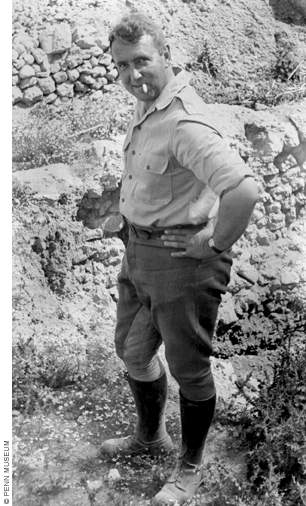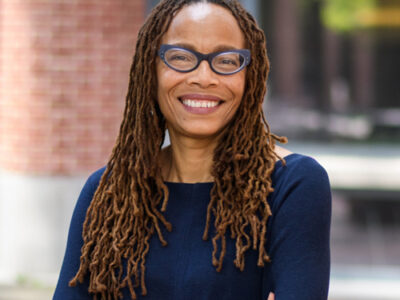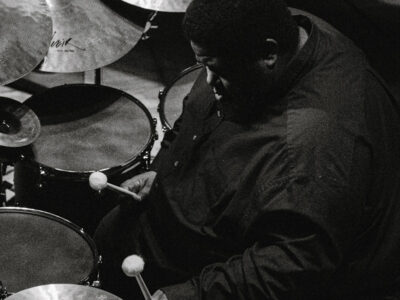
Was Rodney Young the real Indiana Jones? To those who knew the prominent scholar during the quarter-century he presided over Penn’s archaeology department, it sounds like a stretch. But according to a new volume by Susan Heuck Allen, a classical archaeologist who is currently a visiting scholar at Brown University, Young’s past was straight out of the pages of a Robert Ludlum thriller. In Classical Spies: American Archaeologists with the OSS in World War II Greece (University of Michigan Press), Young cuts a figure on par with Jason Bourne—or Bourne’s boss.
Young’s postwar career is well-known and lauded. From 1948 until his death in 1974, he was chair of Penn’s archaeology department and the curator of the Museum’s Mediterranean section. He also earned international acclaim for directing the Penn Museum’s 24-year-long excavation at Gordion in Turkey.
“Gordion is the largest, longest-running archaeological project in Penn’s history,” says Gareth Darbyshire, the Gordion archivist at the Penn Museum. “Dr. Young and his staff excavated more than 200 pieces [of] early Iron Age pottery, some of which transformed our understanding of the evolution of the alphabet. And he found the tombs of kings, including what may have been King Midas’s.”
But for all that Young revealed through his fieldwork, he kept a big secret: a career as an American spy during World War II. In her book (and in remarks delivered in the Rodney S. Young Memorial Lecture at the Museum in September), Allen paints a captivating hidden history. Young was recruited—and then recruited other archaeologists—to work for Special Intelligence (SI), a predecessor of the Office of Strategic Services (OSS), which in turn was a precursor of the Central Intelligence Agency. As the ringleader of a cohort of archaeologist spies, Young masterminded 57 missions inside Axis-held Greece. He created missions to foment armed and passive resistance through sabotage and demolition, and by supplying Greek guerillas with arms, food, and medicine.
Then he apparently put those secrets in a vault and flung away the key.
“Sabotage? Guerillas?” says George Bass Gr’64, pioneer of nautical archaeology and founder of the Institute of Nautical Archaeology [“Gazetteer,” Sept|Oct 2010]. “I’d never have guessed, and he never mentioned it.”
Bass earned his PhD at Penn as a student of Young’s, whom he met at the American School of Classical Studies in 1956. The two spent decades digging together in Turkey and working at Penn, where Bass became an archaeology professor and associate curator of the Mediterranean section. “Never once did Dr. Young mention even being in World War II,” Bass says. “Let alone being part of the OSS.”
Yet it’s not hard for Bass to imagine Young overseeing missions and leading his colleagues into dangerous situations.
“He was absolutely gregarious and an incredibly dominant person,” Bass recalls. “He was a physically large man with a deep voice that rumbled in his belly. He commanded respect, and people—including me—seemed to do what he asked, even if it seemed impossible. His sense of adventure was matched by a confidence that he would succeed in those adventures. And he was very, very private.”
If Young evolved into what his OSS evaluator called a “grade A” operative who “ranks with the best we have had,” he didn’t start life that way. He was born into wealth in 1907. Allen describes him as a “coddled child of the golden age,” a “Cary Grantish darling of New York debutante balls” who was educated at St. Paul’s, Princeton, and Columbia. Not having to earn a living, Young spent six years digging at the Agora in Greece while World War II coalesced around him. In 1940, after war arrived in Greece with the Italian invasion, Young served the Greek resistance by driving an ambulance that he paid for himself. While driving that ambulance, Young sustained a wound sufficiently serious that it later earned him 4F status from the US Army. Sidelined, he was working at Princeton when Benjamin Merritt, consulting for the Foreign Nationalities Branch of SI, and his boss, William “Wild Bill” Donovan, the wartime head of the OSS known as the “Father of American Intelligence,” recruited him to do intelligence work on behalf of the Greeks. Two weeks after Pearl Harbor, the Foreign Nationalities Branch of SI went operational. Young volunteered for active duty.
Why would Young risk his life for the Greeks—and spend the next five years going to greater and greater extremes in that effort? Noblese oblige, a bit of hubris, an acquired philhellenic spirit, and the desire to alleviate the Greeks’ suffering, Allen says. Alessandro Pezzati, senior archivist at the Penn Museum, agrees. “Archaeologists speak the language, walk the country, know the people, and are literally covered in centuries of its dirt,” he says. “They develop strong attachments to the countries they work in, and that particular country at that particular time was facing a real and dangerous threat.”
The Penn Museum Archives are not where Allen found the revelatory material for her book, which details the exploits of a number of scholar-cum-spies. Records housed in the National Archives, declassified in 2004 and 2008, gave her the facts of the missions. To those records, Allen added oral histories to create what she calls a “mosaic” of Young’s wartime activities.
By 1942, Young was leading the OSS’s Greek Desk from Cairo, which Allen describes as “an exotic paradise … like a movie set, teeming with rich refugees, war correspondents in khaki chic, and officers from occupied France, Greece, Yugoslavia, and Poland.”
Young also orchestrated espionage from Alexandria, Cyprus, Istanbul, and Izmir. Assisting him were four male captains and a sorority of female spies, all Americans and leaders in the field of archaeology: Dorothy Cox, Virginia Grace, Margaret Crosby, Lucy Talcott, James Oliver, Jerome Sperling, John Caskey, and John Franklin Daniel III.
Daniel became Young’s link to Penn. From 1940 until he left for Cyprus, Daniel served as associate curator of the Museum’s Mediterranean section. Upon his return in 1948, he became curator of the section and hired Young to fill his old job. That same year, the two men were scouting in Turkey for potential excavation sites when Daniel died at the age of 38. Young succeeded Daniel as curator of the Mediterranean section—and found his way to Gordion, the excavation site that would define his scholarly career.
Now the small handful of colleagues who survived him are left to marvel over Young’s quite different wartime legacy.
Does knowledge of Young’s secret life change how Bass thinks of him?
“Not one bit,” his old friend says. “Rodney Young had a profound effect on my life. I owe more to him than anyone I’ve every worked with. He was an extraordinary human being.”
“Besides,” Bass adds, “lots of us have secrets.”
—Melissa Jacobs C’92




